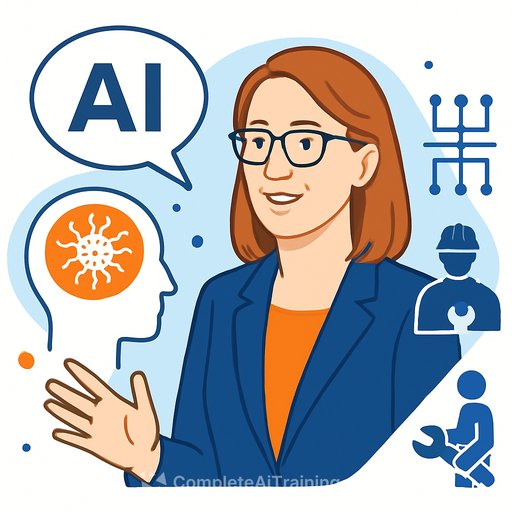Ruth Porat: "We should be able to cure cancer in our lifetime" - what that means for scientists
At the Fortune Global Forum in Riyadh, Google's president and chief investment officer Ruth Porat made a direct claim: with AI, curing cancer within our lifetime is a realistic aim. She framed AI as a force that touches the lab bench, the data center, and the budget sheet - far beyond chatbots. The message to researchers was clear: the breakthroughs are already here, and the bottlenecks are shifting.
AI is more than a chatbot - it's a research engine
Porat highlighted work across Alphabet, noting collaborations with Nobel laureates and the surge in real-world science results. The takeaway isn't hype; it's that AI is now embedded in core discovery workflows, from structure prediction to experimental design. The question she posed: what does this mean for your country, your institution, your lab?
Cancer research: from protein folding to earlier detection
AlphaFold has put 3D protein structures within reach of anyone with a laptop and a research question. It's been called one of the biggest contributions to drug discovery in decades, and its datasets are now a standard reference point in pipelines worldwide. If you work on target validation or hit finding, you're already feeling the shift.
Porat argued that earlier diagnosis is the other side of the same coin. Finding metastatic cells early is a needle-in-the-haystack problem that maps well to AI - similar to spotting malicious code before it spreads. Pair model accuracy with responsible deployment, and you shorten the path from signal to intervention.
Security and productivity: fewer fires, more science
The same pattern-matching that flags metastasis also applies to cybersecurity - identify threats before they cause outages. For research teams, fewer incidents means less downtime for compute and data access. Inside the lab, AI tools that clear administrative load return hours to literature review, protocols, and experiments.
Infrastructure and talent: the quiet constraints
Porat pointed to the basics: energy, grid connectivity, and skilled trades. She cited research suggesting the U.S. could unlock large unused grid capacity through modernization, and noted the shortage of electricians as a real bottleneck for data center buildouts. If your roadmap depends on larger models or on-prem clusters, facilities planning is strategy - not an afterthought.
Google is funding training programs for electricians to meet demand. It's a useful signal: compute ambitions falter without the people who wire, cool, and maintain the systems. For research leaders, align grant timelines and infrastructure lead times early.
Investment cycles: urgency with discipline
Barclays Group CEO C.S. Venkatakrishnan acknowledged the scale of investment underway and the risk of misallocation. His stance: there will be waste in any large cycle, but core infrastructure - and the skilled workers behind it - tends to hold value over long horizons. Choose partners who stay through early friction, not just the headline phase.
Policy and national strategy
Saudi Arabia's Minister of Investment, Khalid Al-Falih, underscored a country-level push on supply chains and energy capacity to support digital infrastructure. Porat echoed that governments everywhere want in, citing estimates of a $200 billion GDP upside for Saudi Arabia and trillions globally. For public research institutions, this is a moment to align proposals with national priorities - compute access, data assets, and workforce development.
What this means for science and research leaders
- Clinical and translational focus: Move from proof-of-concept to validated outcomes - prospective studies, external validation, and meaningful endpoints. Build quantifiable links between model outputs and patient benefit.
- Data readiness: Audit data lineage, consent, and bias. Curate high-signal datasets and document limitations so reviewers and regulators can trust results.
- Model evaluation: Standardize evals that reflect your domain (e.g., variant effect prediction, radiology sensitivity/specificity by subtype, uncertainty estimates).
- Ops and governance: Stand up reproducible pipelines, versioning, and monitoring. Adopt a risk framework early to accelerate approvals.
- Compute strategy: Map workloads to the right mix of cloud, on-prem, or shared HPC. Plan for energy, cooling, and space alongside budget.
- Talent mix: Pair ML scientists with clinicians, biologists, and security engineers. Don't overlook trades - facilities expertise can determine your deployment timeline.
- Security posture: Treat model supply chains like software supply chains. Threat-model your data and weights; test incident response.
- Collaboration: Join consortia that pool data and compute under shared standards. This reduces redundancy and accelerates benchmarks.
Responsible AI isn't optional
Speed without guardrails creates rework. Use established guidance to frame risk, document decisions, and move faster with regulators and ethics boards. It also helps your team say no to fragile shortcuts.
Cancer in our lifetime: a serious target, not a slogan
Porat's line about curing cancer is ambitious - and it sets a useful bar for focus. We're seeing steady progress: protein structure prediction, multimodal imaging models, and screening tools that spot patterns humans miss. The work ahead is integration, validation, and delivery at scale.
If your team is upskilling for this wave
Build a training stack that connects theory to deployed tools - coding, model evaluation, and domain-specific case studies. Curated programs can compress time to value for researchers and technical staff.
Bottom line
The promise isn't abstract. It's new structure predictions driving targets, earlier signals catching disease, secure infrastructure that keeps labs online, and people trained to build and run it. If you lead a research program, this is the moment to rework your plan - data, models, compute, validation - and aim for results that matter in clinic and society.
Your membership also unlocks:






